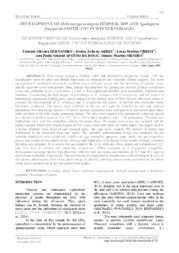Development of Helicoverpa armigera HÜBNER, 1805 and Spodoptera frugiperda Smith, 1797 in winter forages.
Development of Helicoverpa armigera HÜBNER, 1805 and Spodoptera frugiperda Smith, 1797 in winter forages.
Autoria: FERNANDES, F. O.; ABREU, J. A. de; Lucas Martins Christ; ROSA, A. P. S. A. da; MENDES, S. M.
Resumo: Helicoverpa armigera Hübner, 1805 and Spodoptera frugiperda Smith, 1797 are polyphagous pests of great agricultural importance in subtropical and temperate climate regions. The usual management of production areas in the southern region of Brazil occurs after the harvesting of summer crops, and the areas are sown with pasture. Thus, forages recommended for grazing are azevém (Lolium multiflorum Lam.) and cornichão (Lotus corniculatus L.) due to their nutritional benefits, good palatability, regrowth, and hardiness. Considering the high degree of polyphagia of H. armigera and S. frugiperda, and the impact of maintaining continuous feeding areas (green bridges) in the management of these species, this work aimed to evaluate the development of H. armigera and S. frugiperda fed leaves of azevém and cornichão under laboratory conditions. The insects were collected in the city of Capão do Leão/RS in corn and soybean plantations. For each forage species, 130 newly hatched caterpillars were each placed in autoclaved glass tubes, with one-third of the tube length containing forage. The tubes were capped with waterproof cotton and placed in a climate-controlled room at 25 ± 1°C, 70 ± 10% relative humidity, and a 12-h photophase. The food was replenished daily until the caterpillars entered the pupae stage. The pupae were sexed and weighed, and the newly emerged adults were placed in pairs in PVC cages, lined with white A4 sulfite paper. The papers used as a laying substrate were removed and changed daily, and eggs were counted. The number of instars was determined by the linearized Dyar rule model. The complete randomization design was employed for the variables biological cycle length and viability of egg, caterpillar, pre-pupa, pupa, adult, and pre-oviposition phases and weight of caterpillars on the 14th day and pupae after 24 h. Based on the results obtained, a fertility life table was prepared. H. armigera did not complete the cycle, with only three instars and a duration of 22.1 and 24.6 days in azevém and cornichão, respectively. When evaluated in S. frugiperda caterpillars, development in forage species was observed, with five and six instars and duration of 51.7 and 45.1 days in azevém and cornichão, respectively. The azevém was distinguished by interference in the development cycle of the species, reducing the effect of the green bridge. In addition, surviving insects were susceptible to the effects of the agroecosystem due to the low-quality food source.
Ano de publicação: 2020
Tipo de publicação: Artigo de periódico
Unidade: Embrapa Milho e Sorgo
Palavras-chave: Inseto, Lagarta, Planta de Cobertura, Praga de Planta, Resistência
Observações
1 - Por padrão são exibidas publicações dos últimos 20 anos. Para encontrar publicações mais antigas, configure o filtro ano de publicação, colocando o ano a partir do qual você deseja encontrar publicações. O filtro está na coluna da esquerda na busca acima.
2 - Para ler algumas publicações da Embrapa (apenas as que estão em formato ePub), é necessário ter, no celular ou computador, um desses softwares gratuitos. Sistemas Android: Google Play Livros; IOS: iBooks; Windows e Linux: software Calibre.
Acesse outras publicações
Acesse a Base de Dados da Pesquisa Agropecuária (BDPA) para consultar o acervo completo das bibliotecas da Embrapa.

